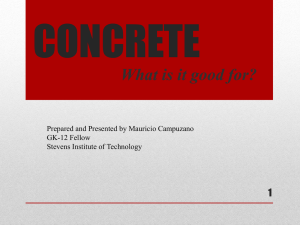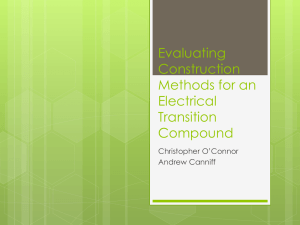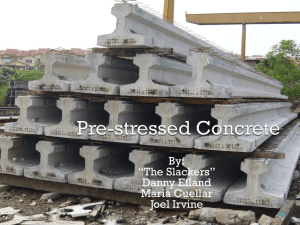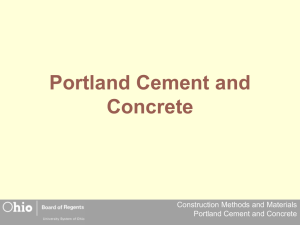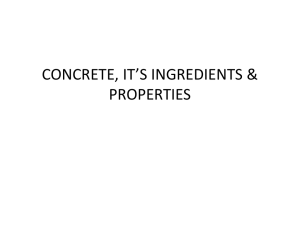File
advertisement
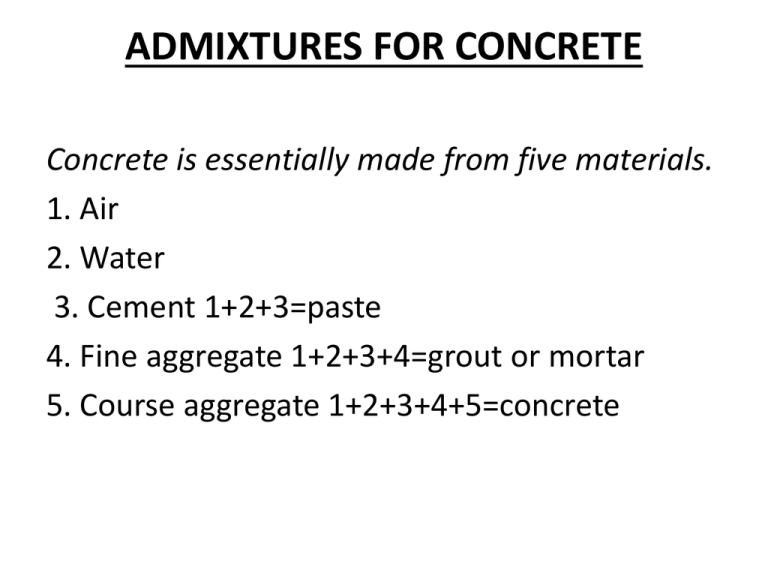
ADMIXTURES FOR CONCRETE Concrete is essentially made from five materials. 1. Air 2. Water 3. Cement 1+2+3=paste 4. Fine aggregate 1+2+3+4=grout or mortar 5. Course aggregate 1+2+3+4+5=concrete Definition • An admixture is a material added to the batch of concrete before or during its mixing to modify its freshly mixed, setting or hardened properties. • About 80% of concrete produced in North America have one or more admixtures. • About 40% of ready-mix producers use fly ash. • About 70% of concrete produced contains a water-reducer admixture. One or more admixtures can be added to a mix to achieve the desired results. Functions The reasons to use admixtures are: • Increase slump and workability; • Retard or accelerate initial setting; • Reduce or prevent shrinkage; • Modify the rate or capacity for bleeding; • Reduce segregation; • Improve pumpability and finishability; • Retard or reduce heat evolution during early hardening; • Accelerate the rate of strength development at early ages; • Increase strength (compressive, tensile, or flexural); • Increase durability or resistance to severe conditions of exposure, including application of deicing salts and other chemicals (air-entraining); Functions Cont….. • Decrease permeability of concrete; • Control expansion caused by the reaction of alkalis with potentially reactive aggregate constituents; • Increase bond of concrete to steel reinforcement (bonding); • Increase bond between existing and new concrete; • Improve impact and abrasion resistance (hardness); • Inhibit corrosion of embedded metal; • Gas-forming; • Anti-washout; • Foaming; and • Produce colored concrete. Groups There are two main groups of admixtures. 1. Chemical 2. Mineral Chemical admixtures Chemical admixtures reduce the cost of construction, modify the properties of concrete and improve the quality of concrete during mixing, transportation, placing and curing. 1. Air-entrainment 2. Water-reducing 3. Set-retarding 4. Accelerating 5. Super-plasticizers 6. Corrosion-inhibitors 7. Shrinkage-reducers 8. Alkali-silica reactivity reducers Air-entrainment • Air-entrainment introduces tiny air bubbles in concrete during the mixing process. It helps protect against damage caused by repeated freezing and thawing cycles. It also imparts better workability, improved homogeneity, decreased segregation and decreased bleeding. • More than 80% of Portland-cement concrete pavements in the United States contain air-entrained admixtures. Entrapped air, are large air voids while entrained air, are tiny voids between 10 to 1000 micrometers. The admixture may be a liquid added during batching or a powder blended with the cement. Some of the most commonly used airentrainment chemicals are: • Salts of wood resins • Synthetic detergents • Salts of petroleum acids AIR ENTRAINING ADMIXTURES EXAMPLES • Sika® AEA-14 Air Entraining Admixture • Sika® Multi-Air Multi component synthetic detergent based air entraining admixture. • Sika® Air Air Entraining Admixture • Sika® AER CA Air Entraining Admixture • Sika® Multi-Air 25 Multi-Component Synthetic Air Entrainer 2. Water-reducing (0.5-2%) • Water-reducing admixtures are added to obtain certain workability (slump) at a lower water-cement ratio (w/c). The slump can be reduced by about 1 to 2 inches without the addition of water. For a given air content, concrete strength is inversely proportional to the water-cement ratio. The reduction in water needed to obtain the desired slump will increase the strength. • These admixtures can reduce the amount of water required by 7% to 10%. The compressive strength may increase as much as 15-20% and the flexural strength may increase as much as 10%. They are used to improve the quality of the concrete and to obtain certain strength at lower cement content. Water reducers are so important in concrete, that they could be considered as one of it ingredients. Examples • Water-reducing admixtures can be categorized according to their active ingredients. There are the following: – salts and modifications of hydroxylized carboxylic acids (HC type); – salts and modifications of lignosulfonic acids (lignins); and – polymeric materials (PS type). Set-retarding • Retarding admixtures delay hydration of cement. They are used to offset high temperature effects, which decrease setting times. Set retarders are used where delay in setting time is required to ensure sufficient placement, vibration or compaction time. Set retarders are used in hot conditions or on very large pours. Set retarders permit application of higher temperature curing of precast/prestressed concrete without negatively affecting the ultimate strength. Setretarding admixtures are the second most commonly used admixture in highway and bridge construction. Examples • Retarding admixtures consists of both organic and inorganic agents. • Organic retardants include unrefined calcium, sodium, NH4, salts of lignosulfonic acids, hydrocarboxylic acids, and carbohydrates. • Inorganic retardants include oxides of lead and zinc, phosphates, magnesium salts, fluorates and borates. • As an example of a retardant's effects on concrete properties, lignosulfate acids and hydroxylated carboxylic acids slow the initial setting time by at least an hour and no more than three hours when used at 65 to 100 degrees Fahrenheit. Accelerators • Accelerating admixtures are added to concrete to shorten the setting time and accelerate the early strength development of concrete. • These are used in cold weather conditions (below 5°C or 41°F). . The benefits of accelerating admixtures are: – Reduced bleeding, – Earlier finishing, – Improved protection against early exposure to freezing and thawing, – Earlier use of structure, – Reduction of protection time to achieve a given quality, – Early removal of form Examples – Some widely used and effective chemicals that accelerate the rate of hardening of concrete mixtures, including calcium chloride, other chlorides, triethanolamine, silicates, fluorides, alkali hydroxide, nitrites, nitrates, formates, bromides, and thiocyanates Super-plasticizers (High-range water-reducing admixtures (HRWR) ) • HRWR admixtures may reduce the water requirement by 12-40%. They are used to produce normal workability at a lower w/c ratio. They may be used to produce a highly flowable concrete (slumps of 8 to 11 inches). • The types of ingredients used fall in three groups: – – – – Sulfonated melamine-formaldehyde condensate (SMF); Sulfonated naphthalene-formaldehyde condensate (SNF); Modified lignosulfonates (MLS); and Polyether-polycarboxylates. • POTENTIAL ADVANTAGES OF HRWR: – – – – – – – – Significant water reduction; Reduced cement contents; Increased workability; Reduced effort required for placement; More effective use of cement; More rapid rate of early strength developme Increased long-term strength; and Reduced permeability. • DISADVANTAGES OF HRWR: – Additional admixture cost (the concrete in-place cost may be reduced); – Slump loss greater than conventional concrete; – Less responsive with some cement; – Mild discoloration of light-colored concrete Corrosion-inhibitors • Reinforcing steel corrosion is a major concern with regard to the durability of reinforced concrete structures. Chlorides are one of the causes of corrosion of steel in concrete. They can be introduced into concrete from deicing salts that are used in the winter months to melt snow or ice, from sea-water, or from concrete admixtures. • One way of combating chlorine-induced corrosion is to use a corrosion inhibiting admixture. These admixtures are added to concrete during batching and they protect embedded reinforcement by delaying the onset of corrosion and also reducing the rate of corrosion after initiation. These admixtures work for many years after the concrete has set. Corrosion-inhibitors are very expensive. Examples • There are inorganic formulation that contains calcium nitrite as the active ingredient and organic formulations consisting of amines and esters. Shrinkage-reducers • Dry shrinkage is the loss of moisture from the concrete as it dries, resulting in a volume contraction. – – – – Dry shrinkage tends to: cracking, Curling of floor slabs, and Excessive loss of pre-stress in pre-stressed concrete. • • The magnitude of dry shrinkage can be reduced by: – Minimizing the unit water content, – Using good quality aggregates, and – Using the largest size course aggregate as possible. Examples • Drying shrinkage can also be reduced significantly by using shrinkage-reducing admixtures. • These are organic-based formulations that reduce the surface tension of water in the capillary pores of concrete, thereby reducing the tension forces within the concrete matrix that lead to drying shrinkage. Alkali-silica reactivity reducers • Alkali-silica reactivity (ASR) is a reaction between soluble alkalis in concrete and reactive silica in certain types of aggregate that results in the formation of a water- absorptive gel that expands and fractures the concrete. • The reaction is: – Typically slow, – Dependent on the total amount of alkali present in the concrete, – The reactivity of the aggregates, and – The availability of moisture. • ASR can be mitigated by: – Using low-alkali cement, – Using sufficient amounts of pozzolans or ground granulated blast-furnace slag, – Using non-reactive aggregates, or – Using lithium-based additives. • Lithium compounds are effective in reducing ASR because they form a non-absorptive gel with the reactive silica in the aggregates. The high cost of lithium- based admixtures, however, has greatly limited their use. • Example – Sika Control ASR


